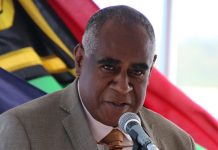Coral Pasisi has been appointed Director of Climate Change and Sustainability (CCES) at the Pacific Community (SPC).
Coral’s extensive experience in the Pacific region spans over 25 years, from the community level to the international level.
Her expertise in regional and international policy, multilateral agreements and arrangements for sustainable development, and climate change financing complements an education background in Earth Science, Development Planning and International Environmental Management Systems.
What inspired you to pursue a career in climate change work in the Pacific?
I was born and raised in Niue, and always had a tremendous sense of respect for the environment and ocean. It served as our playground as children, food cupboard, bank account and the fabric of our community and family gatherings. We were not rich with monetary wealth, but the pristine and abundant ocean and environment provided for all our needs and plenty for future generations. I first learnt about climate change in my first year of University when studying Earth Science. The potential impact to our global environment, Island Countries, their ocean and environment was a great concern to me, and I wanted to be involved in addressing that from then on.
I then lived through one of the largest recorded Category 5 Cyclones in history in the early stages of my career in Niue in 2004, Cyclone Heta. In the course of 6 hours, we lost our only hospital, wharf, bulk fuel depot, Justice Department, only Museum and 95% of our national artifacts, countless homes, churches and sadly loss of life. With 40m wave inundation and winds exceeding 300,km/hr it was clear to me that climate change was not a theory and was, in fact already on our doorstep.
The thought of this kind of event happening more frequently, with massive economic and non-economic loss and damage, was sickening to me personally and professionally. This has underpinned my desire to effect global change in emissions and maximise the flow of resources into the Pacific to build our resilience, adapt and avoid loss and damage as much as possible. We cannot leave behind a world so degraded for our children. This is a debt they should not have to carry and one we must all contribute to reversing.
What challenges have you faced in confronting climate change in the Pacific?
At the global level, the greatest challenge is securing large emitters’ political willpower and commitment to cut GHG emissions and transition the world to a more sustainable development pathway. In our region, there are many challenges. Still, perhaps the one that is most significant and sits at the base of the food chain and affects all others, is sufficient dedicated human capacity of our communities, members, organisations and partners to understand, plan effectively, coordinate, invest in, and address climate change.
This is also the first incremental cost of climate change to a small island developing state. This human capacity should be funded by climate finance from developing countries that have caused mainly climate change. This cannot be in short-term external investments like one-off projects, consultants or short-term readiness programmes. It must be predictable long-term funding that countries and communities can train and retain their people to deal with this issue over a long period. No climate finance sources currently provide this kind of funding support. They are all short-term investments requiring a complex ability to align project after project to avoid gaps in intervention. This is a juggling act very few have succeeded in addressing sustainably and undermines the efficacy of all climate investment.
Naturally, the next significant challenge in confronting climate change in the Pacific is access to climate finance sufficient to address the challenge and deliver in ways that allow the simplest form of management and transaction costs in time, people and finance. Accessing climate finance is a complex and lengthy process, and many Pacific Islands nations need help to secure the necessary funding to implement climate-related actions. Additionally, while some climate finance initiatives are available, the funds are often limited and must be made easier to access.
What is your vision for a more sustainable and equitable Pacific with regards to climate change?
Of paramount importance, the global community (Governments, Private sector and others) need to meaningfully deliver on cutting Green House Gas emissions, otherwise everything we do is just mopping the floor while the tap is turned on. In tandem, Pacific Island nations and communities need to be well-resourced using their own people and systems of delivery wherever possible.
The intergovernmental organisations of the Pacific (CROP agencies), like SPC, the Secretariat of the Pacific Regional Environment Programme, the Pacific Islands Forum Secretariat, the Pacific Islands Forum Fisheries Agency, the South Pacific Tourism Organisation and others, can provide important avenues to support long-term capacity supplementation and specialised technical support and services, to Pacific Island countries to complement their country-lead climate change agendas. But we must be careful to strike the appropriate balance in doing so. Suppose we need more focus on regionalism, with the necessary investment in country-level capability and decision-making. In that case, we risk becoming a burden rather than a solution. It’s critically important that we understand the realities on the ground for our communities and countries.
Having had the privilege of working for SPREP, PIFS and SPC in my career, I see the value the regional architecture can provide for member countries in the region – but we need to improve this visibility and collaboration for members as well. My vision is to create a more precise regional architecture of support for members to engage in and secure support as needed. I would like to see us all advocating and supporting each other no matter what organisation we work for and fully focusing on leveraging incremental and sustainable gains in our countries and communities so they can adapt to climate change and transition to low-carbon economies and opportunities at the earliest. I would like to ensure that our children and theirs inherit a natural environment that allows them to continue to practice our cultures and traditions, learn from lived experiences in the environment, and build sustainable livelihoods that are reinforcing this custodianship into the future.
What strategies and resources does SPC deploy to best serve our member governments and Pacific people?
SPC has its Strategic Plan 2021-2031 as the guide to deploying its full capability, consisting of 8 Divisions, a range of programmes and over 750 staff across the region – addressing nearly every sector of the Sustainable Development Goals. At the centre of our Key Focus Area’s is Resilience and Climate Action, and this is in recognition by our members of the magnitude of the issue. Resilience and Climate Action are everyone’s business.
This is the basis for SPC’s development of a Climate Change Flagship Integrated Programme across the organisation. This seeks to make more explicit our services and capabilities to support climate action in the region, identify where we need to grow this capability to serve members into the future better, and ensure that it is aligned with and complements the work of the rest of the regional architecture.
This flagship also aims to open up the pipes to climate finance for the region by front-loading capability in access to climate finance sources like the Green Climate Fund, the Adaptation Fund and bilateral donors, and project development specialists in the sectors that SPC services like, fisheries, agriculture and forestry, health, Energy, Transport, disaster management, education, statistics, water and human rights and social inclusion. It will draw on our organisation’s important corporate services and back-office support and strengthen that as a critical pooled service in and of itself for the region. We are in the design process now and consulting with partners, CROP and members as we go.
What advice would you give to those interested in pursuing a career in climate change work?
Anchor yourself first in your convictions to add value to addressing climate change in our region. This is often more than a job. It’s a personal commitment in the Pacific. Put yourself in the shoes of the people, communities, and countries we serve and understand the critical role you could play in effecting change in their lives.
Then empower yourself to become the best part of a team you can by educating yourself about the facts of Climate Change and calving out the role you would like to play. Climate change impacts every aspect of life nowadays, so you don’t have to be a Scientist to be in the climate change career space – you can be anything from a human rights specialist, a teacher, a doctor, an elder, an activist, a youth leader, an accountant, monitoring and reporting specialist and many more.
Read about the projections and impacts of climate change on our region and communities, both modern science and traditional knowledge. Also approach regional agencies like SPREP, SPC, PIFS, USP and others to learn more about what is being deployed in the region to support climate action, and get to know the Pacific leaders championing climate change issues on our collective behalf. They are those who dedicate their lives and careers to the very long hours of negotiating in the COP, the Chairs of Pacific SIDS, Pacific Champions on Climate Change, OneCROP team, Pacific youth networks and communicators.
SOURCE: SPC/PACNEWS















